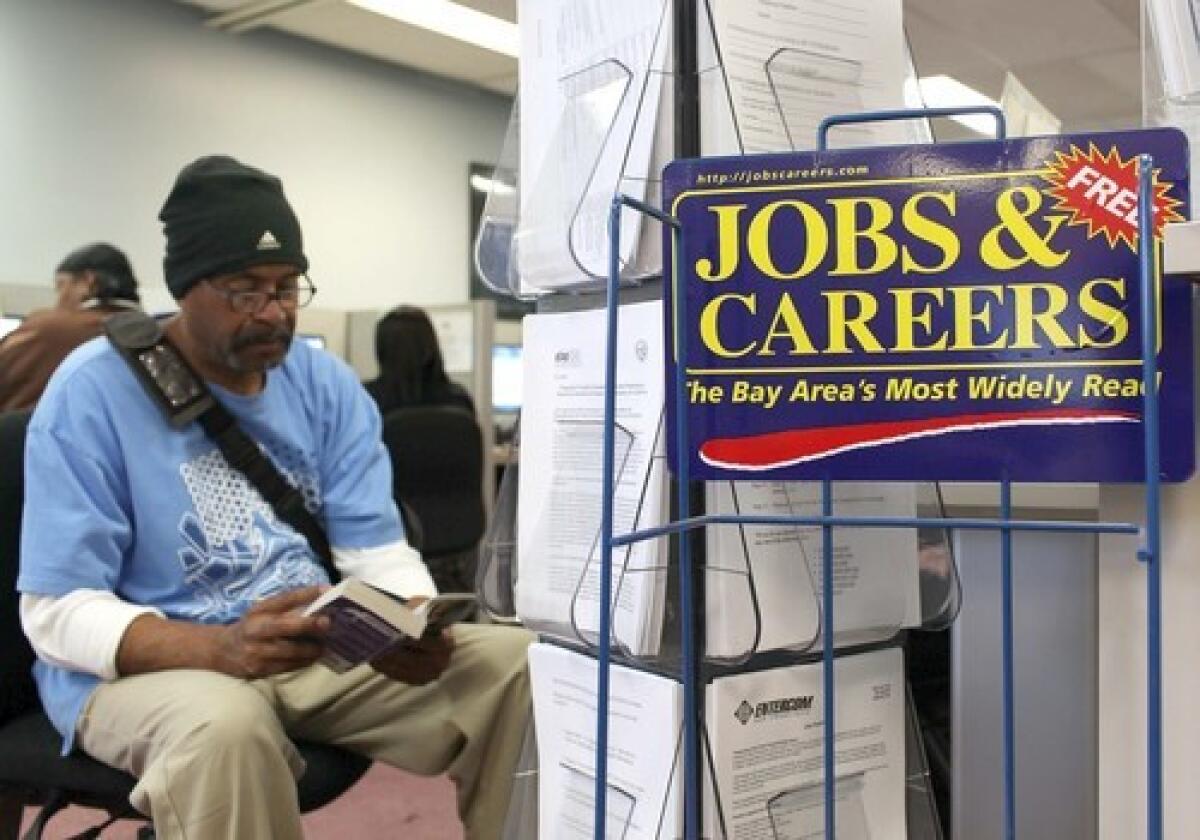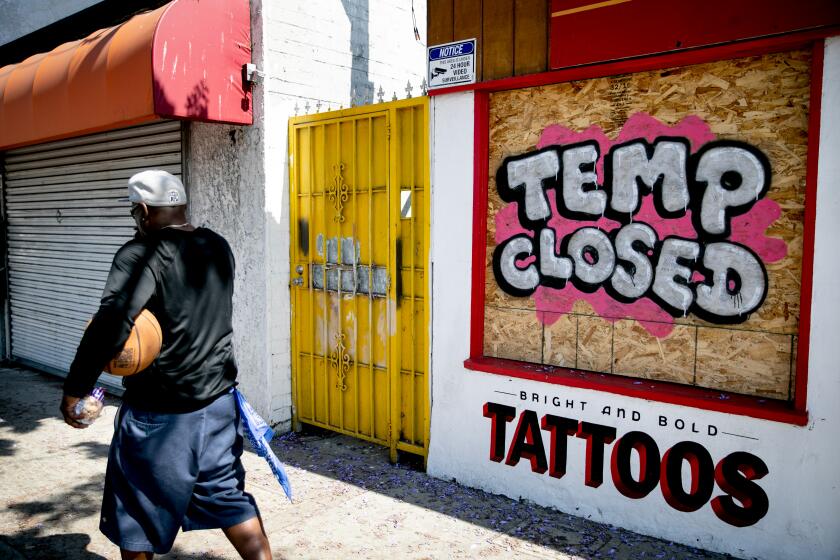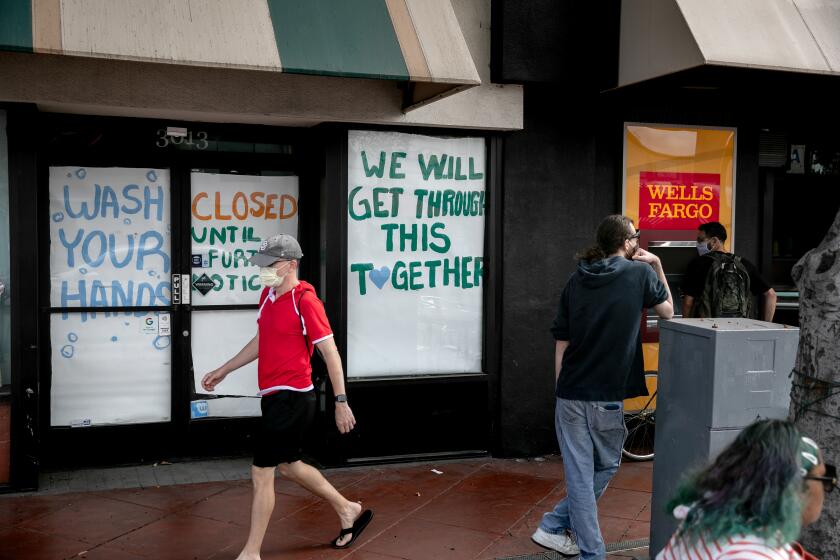A year into pandemic, California’s broken unemployment agency still hurting those in need

- Share via
SACRAMENTO — Nearly a year into the COVID-19 pandemic, California’s beleaguered unemployment benefits system remains mired in dysfunction, leaving many jobless workers in dire straits after their efforts to receive financial assistance have been stymied by jammed phone lines, overwhelmed staff and failed technology.
Millions of out-of-work Californians are still waiting for money they desperately need to feed and clothe their families and avoid ending up on the streets. Payments have instead gone to fulfill fraudulent claims filed in the names of prison inmates, infants, retirees and people living in other states, with a deluge of applications for benefits coming from criminal gangs operating in Russia, China and Nigeria.
Adding insult to injury, state officials acknowledged this week that more than $11 billion in benefits were paid on fraudulent claims during the last year — some 10% of all money paid — and another $19 billion is under investigation for potential fraud.
Now, two new state audits have confirmed what many lawmakers feared was true: The state Employment Development Department failed to prepare for the unprecedented flood of unemployment claims during the pandemic, neglected to fix problems officials identified more than a decade ago during the Great Recession and all but ignored warnings of widespread fraud for months.
“It is clear that this system has broken and will need to be completely overhauled to ensure that these problems never occur again,” said Assemblyman Rudy Salas (D-Bakersfield), chairman of the Joint Legislative Audit Committee, which ordered the emergency auditing of the agency.
The pair of reports on the EDD’s failings from California State Auditor Elaine Howle paints a sobering picture of an agency in crisis, concluding that the state agency “had no comprehensive plan” for the pandemic-spurred recession which “worsened EDD’s already poor performance,” and failed to act on problems that have plagued its unemployment insurance program for at least a decade.
In addition to the confirmed fraud, the state has stopped tens of billions of dollars in payments on bogus claims through tougher security measures, officials said.
“EDD has for years been aware of many of the problems in its [unemployment insurance] claims processing and customer assistance efforts that this report identifies,” said the first audit report released Tuesday. “Nonetheless, EDD did not take adequate steps to address these deficiencies.”
A second report released Thursday concluded that “EDD did not take substantive action to bolster its fraud detection efforts for its UI program until months into the pandemic.”
The EDD’s failure to heed warnings to address its vulnerability to fraud has hamstrung its ability to get money out to those filing legitimate unemployment claims, state lawmakers say. More than 2.1 million claims for unemployment benefits are currently on hold, stuck in a backlog of delayed applications or suspended while the EDD double checks identities to prevent fraud.
And though California is the cradle of the tech industry, state government has also fallen perilously behind in replacing its outdated computer systems, exacerbating its problems with promptly paying out jobless benefits. Just 76.3% of first-time claims in California were approved within 21 days last month, far short of the federal standard of 87%. Most other states are approving more claims faster.
One of those affected by the EDD’s ongoing troubles is Mary Lopez, whose housekeeping jobs dried up with the COVID-19 pandemic. The 50-year-old Fullerton woman said she has ended up sleeping in an RV parked on the street, sometimes scrounging for food in a dumpster behind a nearby store.
Lopez, who is disabled, said she thought state unemployment benefits would have helped keep a roof over her head, but that hope evaporated when her benefits were frozen in October alongside many other claims and she was told she needed more proof of her identity.
The audit noted that in May 2020, the Employment Development Department was warned that California was likely to see $1.2 billion in potential fraud.
Despite spending hours on the phone trying to get through to the EDD, Lopez said she has been unable to receive her benefits. The agency‘s hotline often hangs up on her before she can talk to a live representative, an experience reported by thousands of other claimants over the past year that the EDD said months ago it was working to fix alongside issues with its computer systems.
“I go to bed hungry most of the time and I’m freezing,” Lopez said. “I think it’s disgusting the way we have all been treated by EDD. I don’t want to be on the streets living like this.”
The audit findings released this week mirror conclusions reached by a strike team of government experts appointed by Gov. Gavin Newsom, which said in September that the EDD should be overhauled and called delays in approving benefits and other problems “unacceptable.”
“The state must deliver this benefit to those who qualify within a time frame that’s relevant to the well-being of the claimant, and it was failing to do that for too many Californians,” the report said.
When California entered 2020 with record low unemployment ahead of the pandemic, the EDD had just 20 staffers verifying the identities of claimants, its call center was operating only four hours a day and a years-old project to modernize its outdated technology was was moving at a snail’s pace.
Though EDD has taken steps since March to improve those lagging operations, bringing in thousands of additional workers and hiring private contractors to process claims online, progress has been far outpaced by demand. In the two months after the state’s March 2020 stay-at-home order put many Californians out of work, some 4.1 million claims for unemployment benefits were filed with the state, overwhelming a system staffed for more auspicious economic times.
California has now processed 19.4 million applications for unemployment benefits since the COVID-19 pandemic began and has paid out $114 billion in benefits, nearly five times the amount paid during the worst year of the Great Recession in 2010.
The state auditor’s report was ordered by lawmakers who criticized California’s unemployment agency for a backlog of claims and failing to prevent widespread fraud.
As of this month, more than 3.9 million Californians were still receiving some form of unemployment benefits.
In announcing the strike team last July, Newsom directed action to eliminate the backlog of some 1 million claims delayed longer than 21 days — many of which required additional information from claimants — “no later than the end of September,” a spokesperson for the governor said at the time.
But when that deadline arrived, the Newsom administration said the backlog had grown to some 1.6 million claims and it promised to eliminate the backlog by the end of this month.
As of Monday, nearly all of the claims in the original backlog from September have been resolved, and the rest will be cleared by the end of this month, according to agency spokeswoman Loree Levy. But hundreds of thousands of new claims have come in since September and the backlog of claims stood at 941,000 as of last week.
“While it may be true the claims sitting in backlog in October may not be the same claims sitting there today, the fact remains they [EDD officials] have been unable to meet the challenge, and this comes at the cost of unemployed Californians who are desperately trying to cover the most basic expenses of food and rent,” said Assemblyman Richard Bloom (D-Santa Monica).
To turn the agency around, Newsom brought in six new top managers to the agency in recent months, including Rita Saenz, who was appointed to succeed retiring agency director Sharon Hilliard on Jan. 1.
The governor touted Saenz, a government affairs consultant who was the director of the California Department of Social Services from 1998 to 2004, as “well-prepared to lead EDD at what is sure to be one of the most difficult moments in the Department’s history.”
Saenz acknowledged in testimony to a legislative committee on Tuesday that the agency was not ready to handle the torrent of unemployment claims.
“Simply, we were not prepared,” Saenz told lawmakers. “We were not prepared for the global crisis and the extraordinary strain on the existing employment insurance system. We have an ancient IT system. We have done our best to modernize it, but we still have a lot of problems.”
In an interview, Saenz said similar problems have occurred all over the country, adding that “there is no way the state governments could have anticipated the volume of claims that we are facing.”
John Thomas Flynn, who was California’s first chief information officer from 1995 to 1999 and previously headed the technology office for the state of Massachusetts, disputed the assessment that California could not have taken steps in anticipation of a spike in unemployment. He said there are states that modernized their unemployment systems in recent years, including Massachusetts, Texas, Nevada and Washington, “who were prepared and had far fewer problems” than California.
“Unfortunately, while there have been fits and starts at EDD over the years, there has never been a sense of urgency to address the problem once and for all,” said Flynn, a senior advisor for MeriTalk, which provides analysis and events aimed at improving government information technology.
A budget report released by the governor on Jan. 8 underscored Flynn’s point. A project to modernize EDD’s antiquated technology was still floundering in September, when the governor’s strike team said it had been in the planning process for three years.
“The contractor has not yet been selected and not a single line of software code has been written,” the strike team found. The strike team recommended the EDD rethink the long-term project and an evaluation is underway.
To address the crisis in the short term, EDD approved contracts with private firms including identify verification service ID.me, which began in October to process new claims electronically, reducing the number of applications that must go through a manual process.
Saenz said she is evaluating additional ways to further improve EDD operations.
“I’m looking to make an assessment of how the department and its business offices need to be reorganized in order to give us a ship that is agile and responsive,” Saenz said, offering no timeline for when the assessment will be complete.
In the months after the pandemic began, the EDD added the manpower of some 5,000 people through hiring, contracts and transfer of state employees from other jobs to boost efforts to answer phones and process claims. In April, a call center answering phone calls from claimants was expanded from operating four hours a day, five days a week to 12 hours a day, seven days a week.
But unemployed Californians have continued to report disconnected calls and difficulty reaching a live service representative.
Though the EDD received 4.8 million phone calls from Dec. 20 to Jan. 2, just 8% — 400,397 — of them were answered by staff, the agency reported this month.
“EDD has at times been unable to help virtually any of the claimants that contact its call center and has not answered all web correspondence that claimants submit,” said the audit released Tuesday.
Mary Anne Babcock lost work as a gig driver and is living in a van in Temecula without access to unemployment benefits since her EDD debit card was frozen more than three months ago. After enlisting help from her state senator, her card was unfrozen, but payment of benefits owed is still pending.
Numerous calls to EDD to get help on the phone have been unsuccessful, she said.
“I’ve lost my home, my job, my benefits and my mind. I’m living in my van, with no hope,” she said.
EDD officials said they notified claimants on New Year’s Eve that, in an attempt to prevent fraud, the agency was suspending payments on 1.4 million claims pending new identity verification. That has left many jobless Californians struggling to be recertified so they can pay their rent and buy groceries, even after Congress agreed to extend $300 supplemental weekly benefits.
As the official ultimately responsible for the EDD, Newsom has voiced his own frustration with its problems, saying in September that the delays were “unacceptable and so was the condition of the system when we inherited it.”
The troubles at the EDD represent a political liability for the governor, becoming an issue in a recall campaign that has submitted 720,000 signatures — about half of those needed to qualify the measure for the ballot and of which only 410,000 have been verified.
“His crisis at the Employment Development Division has been one of his biggest failures,” said Randy Economy, a senior advisor for the recall campaign.
Newsom announced a budget this month for the fiscal year beginning July 1 that includes an additional $766.3 million and 3,976 positions in the unemployment insurance program “to align with projected workload increases as a result of rising unemployment due to the COVID-19 pandemic.” The budget also includes $11.4 million for the California Department of Technology to review and improve services for key departments including the EDD.
But lawmakers said this week that they have run out of patience with EDD as their offices continue to be flooded with desperate calls from constituents seeking help on stalled claims. And with the state audit outlining a host of problems more than a decade old, it remains unclear when and if the troubled agency will get its house in order.
“EDD has failed to deliver,” said Assemblyman Phil Ting (D-San Francisco), the Assembly’s budget chairman. “I know constituents who became homeless because it took so long for them to receive their unemployment benefits.”
More to Read
Sign up for Essential California
The most important California stories and recommendations in your inbox every morning.
You may occasionally receive promotional content from the Los Angeles Times.














